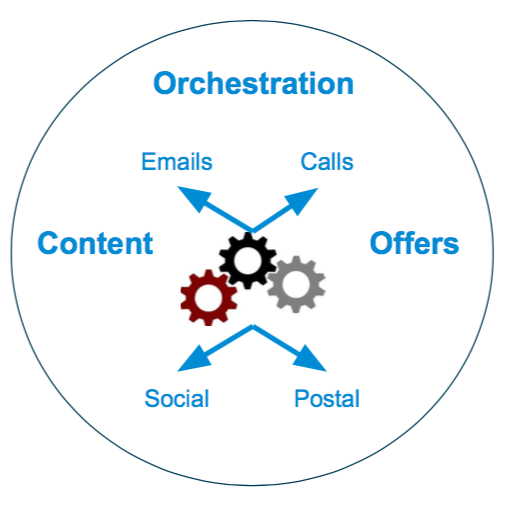 Challenge: Accurately Reporting Marketing Contribution Without Over-Investing Time and Budget
Challenge: Accurately Reporting Marketing Contribution Without Over-Investing Time and Budget
For many years marketing teams have aimed to identify their contributions to their companies’ success. Over the last five years, there have been significant advances in the tools available as well as the business processes by which data can be managed to support greater insights and gain competitive advantage. In fact, marketing groups today are frequently responsible for driving a specific percentage of company revenue so identifying revenue sourced by Sales or Marketing is critically important to measuring business performance.
But measuring marketing contribution is time, resource, and budget hungry. So how much should you invest? What tools will contribute to success given the maturity of your organization? In working with many different organizations, I have noticed common themes on the road to attribution maturity. Knowing where you are on this maturity timeline will help you plan for what may come next for your organization. While every company is unique, I believe there are common attribution lifecycle stages – and companies move through them as they need greater detail and insight.
So check out where you in attribution maturity so you can balance investment against the value of increasing visibility.
Stage 1 – Early Startup
- Definition: Sales and Marketing have agreed upon revenue contribution percentages
- Typical Revenue: $0-$500K ARR
- Sales-Marketing Alignment: Handshake agreement on total new account revenue sourced by Marketing vs. Sales
- CRM Deployment: Early deployment often still optimizing data and reporting process/structure
- CRM Usage: Consistent campaign association is not yet defined for Leads, Contacts and Opportunities; Marketing automation may not be integrated with CRM
- Attribution Process: Manual monthly or quarterly update of opportunities as Marketing vs. Sales sourced
- Primary Challenges: Manual update of opportunities becomes overly time consuming
Stage 2 – Maturing Startup
- Definition: CRM deployed with basic campaign attribution reporting
- Revenue: $500K ARR – $5M ARR
- Sales-Marketing Alignment: Attribution to Marketing or Sales identified and defined by first or last touch for new business; starting discussion on up-sell and cross-sell attribution
- CRM Deployment: CRM standard utilization enforced, Sales forecast process optimization ongoing, Marketing automation integrated
- CRM Usage: Both Sales and Marketing have created a data dictionary and have established standard processes for updates that have moderately successful usage
- Attribution Process: CRM reporting using first or last touch for Marketing vs. Sales attribution
- Primary Challenges: Both first and last touch neither accurately describe opportunity drivers nor comprehensively reflect Marketing and Sales program impacts
Stage 3 – Growth Startup
- Definition: Specialized attribution software deployed in first version
- Revenue: $5M ARR – $50M ARR
- Sales-Marketing Alignment: Comprehensively defined Sales vs. Marketing source new business, upsell/cross-sell business and optimization of handoff processes
- CRM Deployment: Utilize industry best practices for data integrity and reporting, generally solid compliance from Sales and Marketing teams, and relatively accurate sales forecasting; Initial deployment of third-party attribution tools
- CRM Usage: Sales operations focusing on tight rep compliance with CRM, Marketing Operations focused on data quality and completeness
- Attribution Process: Sales vs. Marketing sourced opportunities identified by campaign touches driving the MQL; utilizing both Sourced and Influenced models to optimize marketing performance
- Primary Challenges: When sourced and influenced models do not accurately capture full account-based attribution impact or when weighted touch models are required to adjust campaign influence over customer journey
Stage 4 – IPO Readiness and Public Company
- Definition: Specialized attribution software deployed in second iteration
- Revenue: $50M ARR – $500M ARR+
- Sales-Marketing Alignment: Business operations teams fully integrated across Sales and Marketing with BI dashboards/reporting; Monthly/Quarterly attribution reviews for program and process optimization; Early deployment of predictive revenue models
- CRM Deployment: Sophisticated CRM deployment managed by business operations team with sophisticated reporting (BI tools) and data accuracy for regulatory compliance
- CRM Usage: Well established guidelines and training; key processes are reinforced with end user compliance
- Attribution Process: Multiple attribution models including weighted touch attribution and account-based models supported by analytics team to assist in utilization and interpretation of the data
- Primary Challenges: Managing time, cost and complexity of attribution reporting as well as the ability of most marketing team members to absorb the complexity of these models
What has been your experience? Do these levels ring true? Was this helpful to your planning?
Lesson: As organizations grow, so do their needs for better attribution. It is important to make the right investments at the right time to keep attribution management time and costs in line with overall revenue goals.


